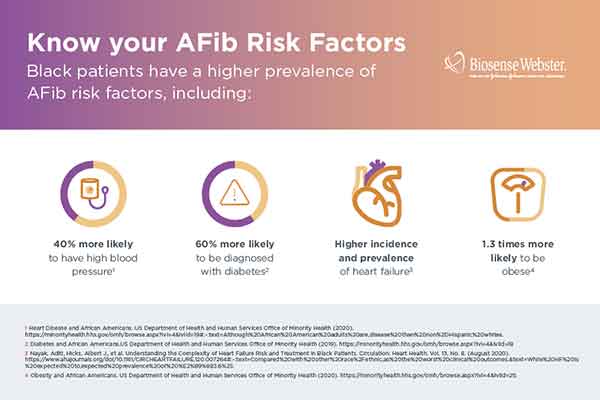My Heart Can't Wait: Understanding Racial Disparities in AFib
02/20/2021 03:31AM ● By Family Features
The facts are troubling: Black Americans are more likely to have a number of serious illnesses, including diabetes, high blood pressure and heart disease. And, members of the Black community are 30% more likely to die from heart disease and twice as likely to have a stroke compared to other ethnic and racial groups.
February is Black History Month and Heart Health Month in the U.S., providing an opportunity to highlight health care disparities that affect the Black community, specifically when it comes to the most common type of heart rhythm disorder, atrial fibrillation (AFib).
 AFib is an irregular heart rhythm that can increase the risk of stroke and heart failure. Affecting more than 5.5 million people in the United States, AFib may cause symptoms including, but not limited to, palpitations, fatigue, shortness of breath and difficulty exercising. The Black population is at a higher risk of complications from AFib.
AFib is an irregular heart rhythm that can increase the risk of stroke and heart failure. Affecting more than 5.5 million people in the United States, AFib may cause symptoms including, but not limited to, palpitations, fatigue, shortness of breath and difficulty exercising. The Black population is at a higher risk of complications from AFib.
“Patients, no matter their race or gender, deserve to be educated and informed of their options so they can take charge and become proactive partners in their own care,” said Dr. Charles Athill, cardiac electrophysiologist. “Health disparities in AFib lead to unnecessary complications including stroke, other heart diseases and even death. As a cardiologist for more than 22 years who has taken care of thousands of patients, I’ve seen the suffering firsthand that AFib and the associated risk factors can cause, especially in the Black community. This also includes my own family, as my father died from complications of AFib due to misunderstanding his treatment plan and the importance of compliance.”
One of the most important risk factors for AFib is high blood pressure, and Black adults are 40% more likely to have high blood pressure, resulting in a 30% higher death rate for heart disease. Additionally, the Black community is more likely to have other AFib risk factors such as diabetes, congestive heart failure and obesity.
Early diagnosis is important as AFib is a progressive disease that may become more severe if left untreated. However, Black AFib patients are approximately one-third as likely to be aware they have AFib. This lack of awareness and reduced likelihood of treatment puts them at a higher risk of stroke and mortality.
These disparities make seeking a diagnosis and understanding treatment options for AFib critical for the Black community. Medications are often the first attempt at treating AFib, but if medications don’t work, catheter ablation – a minimally invasive procedure performed by electrophysiologists (heart rhythm specialists) – is a safe and effective treatment option.
Catheter ablation can improve quality of life and allow patients to get back to doing the things they love. As with any medical treatment, however, catheter ablation has potential risks including bleeding, swelling or bruising at the catheter insertion site and infection. Serious complications are rare but can include damage to the heart or blood vessels, blood clots (which may lead to stroke), heart attack or even death. The success of this procedure depends on many factors, including a person’s physical condition and ability to tolerate the procedure. This is why it’s important for patients to have open discussions with their physicians and carefully select them based on their skill and experience.
To learn more about AFib, or to find an electrophysiologist near you, visit GetSmartAboutAFib.com.
Photo courtesy of Getty Images



